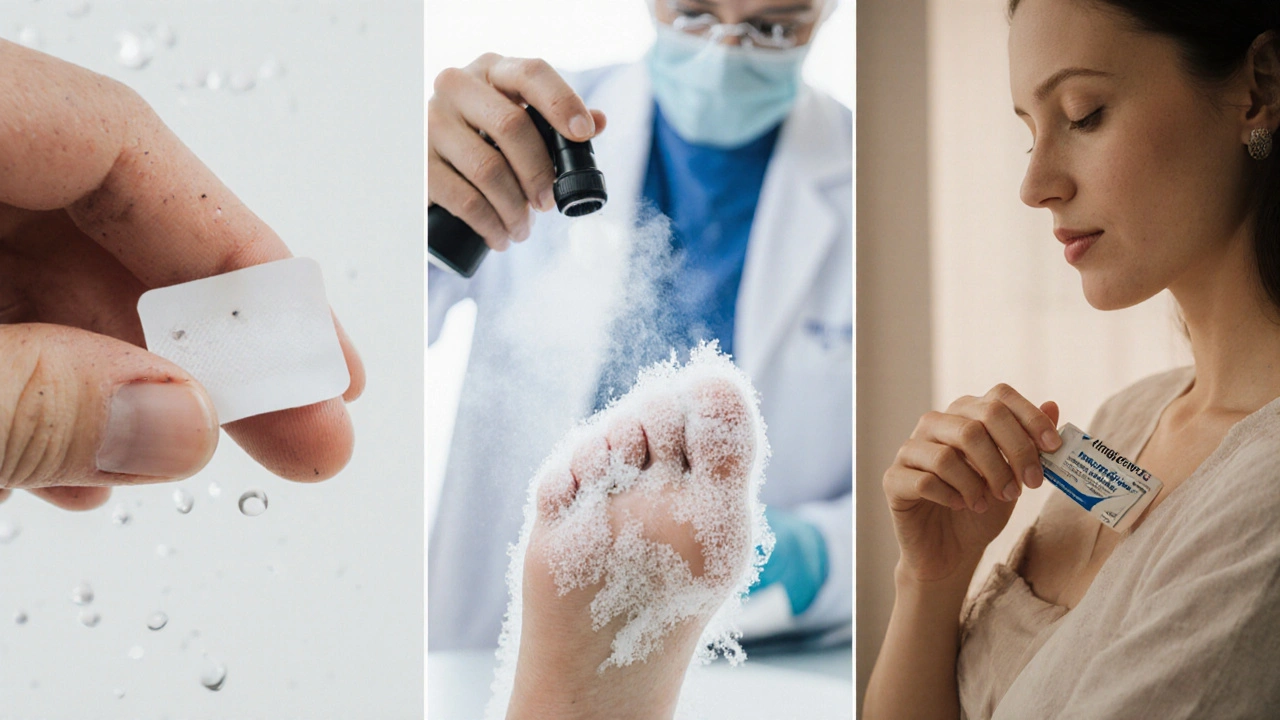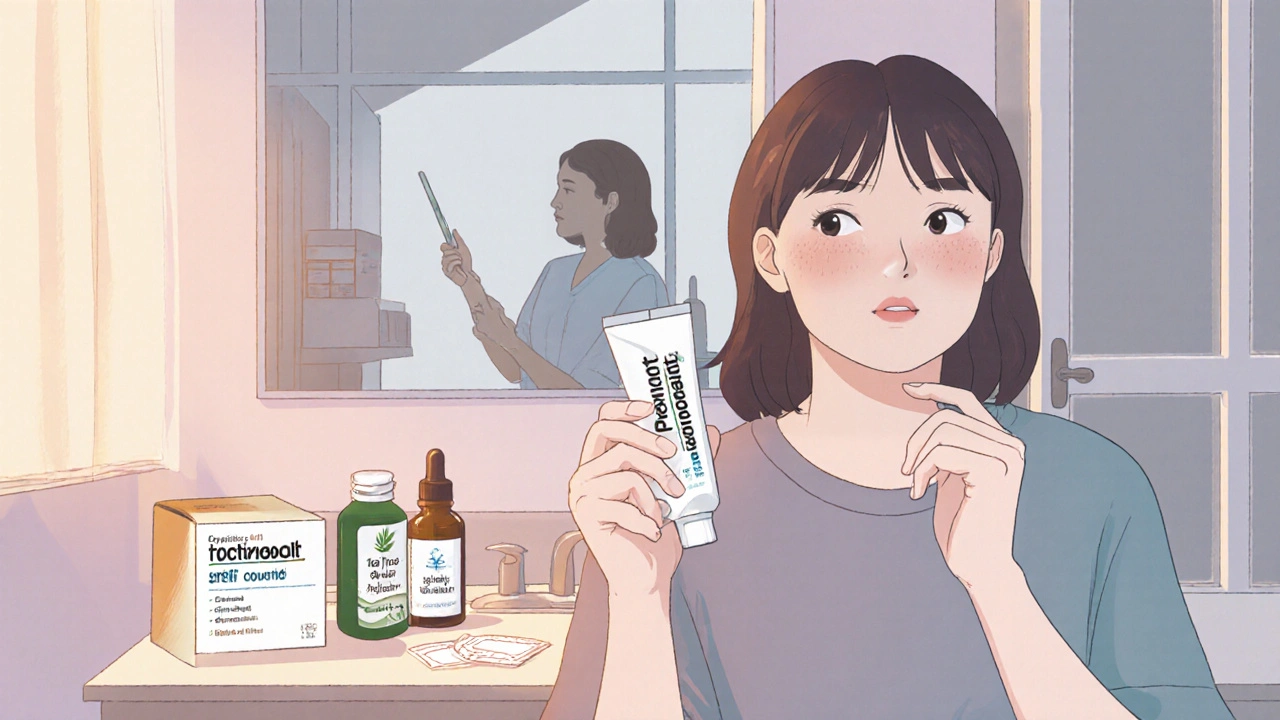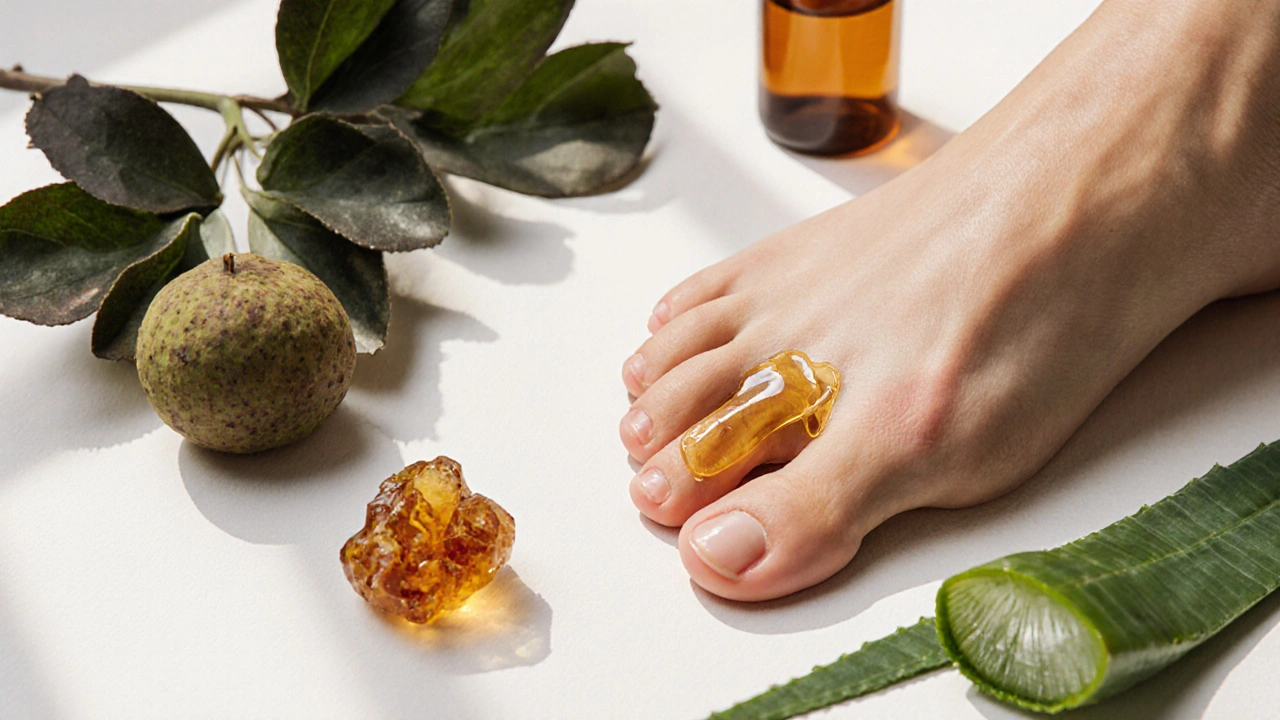Wart Treatment Recommendation Tool
Find Your Best Wart Treatment
Answer these questions to get personalized recommendations based on the latest medical evidence.
Your Recommended Treatment
When a stubborn wart refuses to go away, the market offers a slew of creams, gels, and home‑remedies. One of the more talked‑about products is Podowart, a blend of podophyllum resin, benzoin, and aloe vera. If you’ve heard the name and wonder how it stacks up against other options, this guide walks you through the science, the pros and cons, and the situations where each remedy shines.
Key Takeaways
- Podowart combines a strong plant‑derived resin with soothing aloe, making it effective for thick, hyperkeratotic warts.
- Salicylic acid remains the most accessible over‑the‑counter (OTC) choice, ideal for small, superficial warts.
- Imiquimod and cryotherapy provide higher cure rates for resistant warts but require prescription or professional administration.
- Natural oils such as tea tree and willow bark offer mild antiviral activity with minimal irritation.
- Choosing the right treatment hinges on wart size, location, pain tolerance, and whether you prefer DIY or clinical care.
What Is Podowart?
Podowart is a topical gel formulated for the treatment of common warts, plantar warts, and verrucae. Its primary active ingredient, podophyllum resin, is extracted from the American mayapple plant (Podophyllum peltatum) and has a long history of use as an antiproliferative agent. The resin interferes with DNA synthesis in rapidly dividing cells, which includes the virus‑infected keratinocytes that make up a wart.
Two supporting components round out the formula: benzoin acts as a mild antiseptic and skin‑protectant, while aloe vera provides soothing moisture to reduce irritation.
How Podowart Works
The three ingredients play distinct roles:
- Podophyllum resin penetrates the stratum corneum and binds to tubulin, halting cell division. In wart tissue, this translates to gradual shrinkage and eventual sloughing off.
- Benzoin creates a protective film that limits excess drying, which can otherwise cause cracking and secondary infection.
- Aloe vera supplies polysaccharides that retain water, easing the burning sensation many users report.
Clinical reports from the early 2000s show cure rates around 55‑65% after a 6‑week course applied twice daily, provided the user follows the recommended cleaning protocol.

Popular Alternatives to Podowart
Below is a quick snapshot of the most common wart‑treatment options you’ll encounter:
- Salicylic acid - OTC keratolytic, typically 17% to 40% concentration, works by softening the wart’s callus layer.
- Imiquimod - Prescription immune‑modulator, stimulates interferon production to target HPV‑infected cells.
- Cryotherapy - In‑office liquid nitrogen blast, freezes the wart tissue leading to necrosis.
- Tea tree oil - Essential oil with antiviral and anti‑inflammatory properties, applied topically.
- Willow bark extract (Salix alba) - Naturally sourced salicylic acid precursor, offers gentle exfoliation.
- Cantharidin - Blister‑inducing agent used by dermatologists for recalcitrant warts.
Side‑by‑Side Comparison
| Attribute | Podowart | Salicylic Acid | Imiquimod | Cryotherapy | Tea Tree Oil |
|---|---|---|---|---|---|
| Formulation | Gel (podophyllum resin + benzoin + aloe vera) | Liquid/patch (17‑40% salicylic acid) | Cream (5% imiquimod) | Liquid nitrogen (−196°C) | Essential oil (≈5% terpinen‑4‑ol) |
| Prescription required | No (OTC in many regions) | No | Yes | Yes (administered by clinician) | No |
| Typical cure rate | 55‑65% (6‑week regimen) | 40‑50% (8‑12weeks) | 70‑80% (16‑weeks) | 80‑90% (1‑3 sessions) | 15‑25% (variable) |
| Pain/irritation | Moderate burning (often mitigated by aloe) | Mild stinging, possible skin peeling | Redness, itching, flu‑like symptoms | Sharp cold sting, blistering | Minor tingling, rarely allergic |
| Cost (US$) | ≈$12‑$18 per 30g tube | ≈$5‑$10 per 30g bottle | ≈$250 per 5‑g tube | ≈$100 per session | ≈$8‑$12 per 15ml bottle |
| Ideal for | Thick plantar or common warts, users wanting a single‑step formula | Small, superficial warts, budget‑conscious DIYers | Persistent or genital warts, immune‑modulated approach | Large, painful warts needing rapid removal | Mild cases, those preferring natural oils |
Pros and Cons of Each Option
Podowart offers a blend that targets viral cells while soothing the skin, but the burning sensation can be off‑putting for sensitive areas like the face.
Salicylic acid is cheap and easy to find, yet it works slower and may require weekly filing, which some people find messy.
Imiquimod delivers one of the highest cure rates, but the prescription cost and potential flu‑like side effects limit its appeal for occasional warts.
Cryotherapy provides quick results in a clinic, but the pain of freezing and risk of hypopigmentation make it less attractive for people with darker skin tones.
Tea tree oil is gentle and natural, perfect for kids or pregnant users, but the modest efficacy means it’s often a supplementary rather than primary treatment.

How to Choose the Right Treatment
Consider these decision criteria before picking a remedy:
- Wart type and location: Plantar warts respond well to podophyllum resin; facial warts need milder agents.
- Budget: OTC options (salicylic acid, tea tree oil) are under $15; prescription or clinic services climb into the hundreds.
- Pain tolerance: If you dislike burning or freezing, stick to aloe‑based gels or oils.
- Timeframe: Cryotherapy can clear a wart in one or two visits; topical gels may need weeks.
- Medical history: Immunocompromised patients should avoid strong immunomodulators without doctor supervision.
For many people, a step‑wise approach works best: start with an OTC salicylic acid or a mild oil, and if the wart persists after 8weeks, graduate to Podowart or seek professional cryotherapy.
Common Mistakes to Avoid
- Skipping the pre‑application cleaning step - debris can block absorption.
- Applying too much product - especially with Podowart, excess can cause skin ulceration.
- Using the same treatment on multiple wart types without adjustment - genital warts need prescription‑only agents.
- Neglecting follow‑up - if a wart doesn’t improve after the recommended course, switch therapies rather than continuing indefinitely.
Next Steps
If you’ve decided to try Podowart, follow this simple routine:
- Wash the affected area with mild soap and warm water; pat dry.
- Apply a thin layer of the gel using a disposable applicator; avoid surrounding healthy skin.
- Leave on for 4‑6hours (nighttime works well), then wash off.
- Repeat twice daily for 6weeks, monitoring for redness or excessive pain.
- If no improvement after the full course, consult a dermatologist for possible cryotherapy or prescription options.
For those preferring a natural route, a daily blend of tea tree oil (2drops) with a carrier oil can be applied after cleaning; consistency is key, and results may appear in 8‑12weeks.
Frequently Asked Questions
Can I use Podowart on my face?
Podowart’s podophyllum resin is potent and can irritate delicate facial skin. Dermatologists usually recommend a lower‑strength salicylic acid or a prescription cream for facial warts. If you still want to try it, test on a small patch and stop at any sign of burning.
How long does it take to see results with Podowart?
Most users notice a reduction in wart size within 2‑3weeks, but complete clearance often requires the full 6‑week regimen. Patience and consistent application are essential.
Is Podowart safe for children?
The product is generally labeled for ages 12 and up. For younger children, gentler options like aloe‑based oils or pediatric‑approved salicylic acid pads are preferred.
Can I combine Podowart with other treatments?
Mixing topical agents can increase skin irritation and reduce effectiveness. It’s best to finish one course before starting another, unless a doctor advises a combined protocol (e.g., cryotherapy followed by a Podowart maintenance phase).
What should I do if I develop a blister after using Podowart?
A mild blister can be a sign that the resin is working, but if it becomes painful, large, or shows signs of infection, stop use immediately, clean the area with saline, and seek medical advice.


Comments
siddharth singh
When dealing with stubborn warts, it is essential to understand the underlying virology, the keratinocyte proliferation cycle, and how each topical agent interferes with that process. Podowart, for instance, contains podophyllum resin, a potent antimitotic compound that binds tubulin and arrests mitosis in the hyperproliferative wart tissue. This mechanism is fundamentally different from salicylic acid, which primarily acts as a keratolytic agent, softening the hyperkeratotic layer to facilitate mechanical removal. The addition of benzoin in Podowart provides a protective barrier that reduces transepidermal water loss, while aloe vera contributes anti‑inflammatory polysaccharides that mitigate the burning sensation commonly reported with podophyllum applications. Clinical studies from the early 2000s reported cure rates of approximately 55‑65% after a six‑week regimen, which is comparable to the 40‑50% rates observed with high‑strength salicylic acid over an eight‑to‑twelve‑week period. In contrast, cryotherapy, which delivers rapid tissue necrosis via liquid nitrogen, achieves cure rates upward of 80‑90% but requires professional administration and often results in significant discomfort and potential hypopigmentation. Imiquimod, a prescription immune‑modulator, offers the highest cure rates (70‑80%) but carries systemic side effects such as flu‑like symptoms and is cost‑prohibitive for many patients. From a cost‑benefit perspective, Podowart sits in a middle ground: it is OTC in many regions, priced around $12‑$18 per tube, and does not require clinical visits, making it an attractive option for patients who prioritize convenience over the fastest possible resolution. However, users must be vigilant about application technique; excessive amounts can cause ulceration, and the gel should be applied only to the wart surface, avoiding surrounding healthy skin. Pre‑treatment hygiene – cleaning the area with mild soap and ensuring it is dry – enhances absorption and reduces infection risk. It is also advisable to monitor the wart for signs of adverse reaction, such as excessive blistering or increasing pain, and to discontinue use if these occur. For immunocompromised individuals, the efficacy of podophyllum may be reduced, and stronger prescription therapies should be considered under medical supervision. Overall, the decision matrix for wart treatment should incorporate wart type, location, patient pain tolerance, budget, and treatment timeframe, with Podowart representing a viable, balanced choice for many common and plantar warts when used correctly.
October 12, 2025 AT 19:04
Angela Green
Your summary is comprehensive, however there are a few grammatical nuances worth noting: use "hyperkeratotic" instead of "hyper‑keratotic" for consistency, and remember that "efficacy" is a noun, not a verb, so the phrase should read "the efficacy of podophyllum may be reduced". Also, when listing items, the Oxford comma before "and" improves readability – for example, "pain tolerance, budget, and treatment timeframe". Great job overall, the content is both thorough and engaging!
October 27, 2025 AT 02:04
April Malley
Wow, what a detailed breakdown! I love how you covered every angle, from the chemistry of podophyllum to the practical tips like cleaning the area, and even the cost comparison – it really helps anyone trying to decide what’s best for their warts, especially when budget is a concern, and the tone is friendly enough that I didn’t feel overwhelmed by the science.
November 10, 2025 AT 10:04
scott bradshaw
Sure, because spending $100 on a freeze is totally reasonable when you could just buy a gel.
November 24, 2025 AT 18:04
Crystal Price
Ah, the drama of choosing a wart cure! You’re told to pick a potion, yet the world seems to conspire against smooth skin. Remember, the true battle is not just against the wart, but against the fear of looking imperfect. Simplicity may be the ultimate elegance in this skincare saga.
December 9, 2025 AT 02:04